Choice
Provide students with choices for what literacy texts and materials they wish to use and also the kinds of products they want to create to demonstrate their learning. Below are some tools that students can use to exercise choice in their literacy learning.
Challenge
Provide students with moderately challenging open literacy tasks that are meaningful and engaging. Below are some tools teachers can use to provide students with challenging and meaningful literacy tasks.
Constructing Meaning
Provide open literacy activities and tasks that allow students to make sense of literacy materials and recognize the importance of such activities and tasks. The below tools can help students construct meaning during literacy instruction by providing platforms for meaningful learning.
Consequences
Students feel positive about learning when they engage in open literacy activities that have many right answers and that focus students on evaluating their progress in relation to the processes they used, if they achieved their goal, and if they did their best. The following technology tools can be used to create open literacy activities.
Materials:
World Digital Library: America.gov provides this on-line site. "The World Digital Library (WDL), launched April 21, offers free online access to rare and important cultural materials from libraries and archives around the world. It is a project of the U.S. Library of Congress, the United Nations Educational, Scientific and Cultural Organization, and more than 30 partner institutions. Every country in the world is invited to participate."

Universal Digital Library (UDL): This site provides access to many digital books from various cultures and in various languages.

Google.com: Students can use this search engine to explore possible reading topics. They can also use Google News to search for current news stories.
Webs.com: Students can read the websites of professionals and noted people to learn about topics of interest.

Blogger.com: Students can read the blogs of noted people to learn about topics of interest.
RSS Feeds: Students can subscribe to high-quality sources of information on topics of interest.
Webquests: Students can view and read webquests about topics of interests.
Products:

Flickr.com: Students can use this site to work with photographs. They can create collages, photo books and more, as well as, share their photo projects with other students on-line. li

Slide.com: students can make photo presentations and share them on-line with other students.

Audacity: This program allows students to make audio recordings.

Microsoft Photo Story 3: Students can use this free download to create photo stories. Students can also scan any kind of item, such as magazines, old photos, and drawings, and make it part of their digital photo story.

Podomatic.com: Students can use this free software to create podcasts.

Letterpop.com: Students can use this site to create, publish and share newsletters.
Comments (0)
You don't have permission to comment on this page.